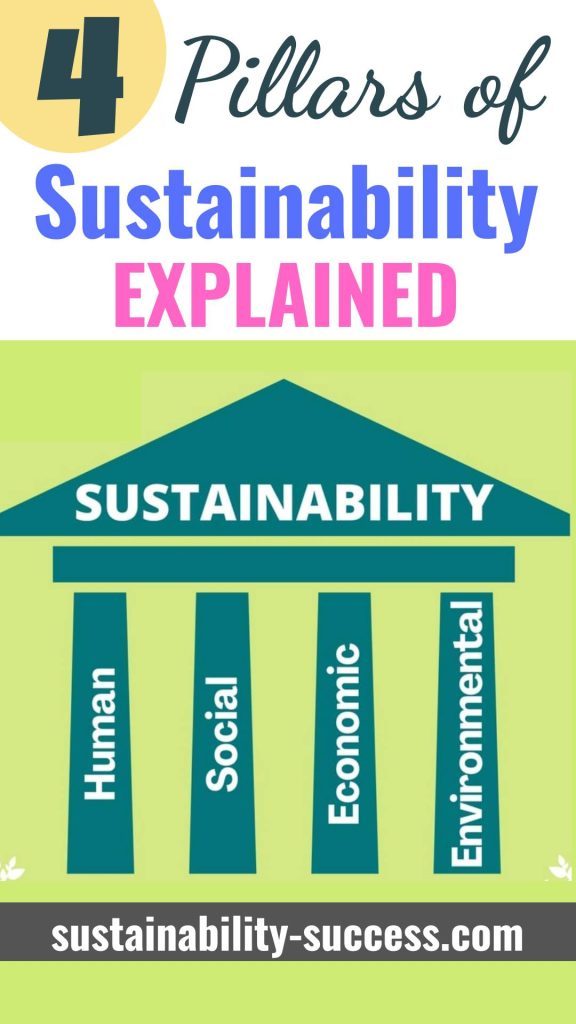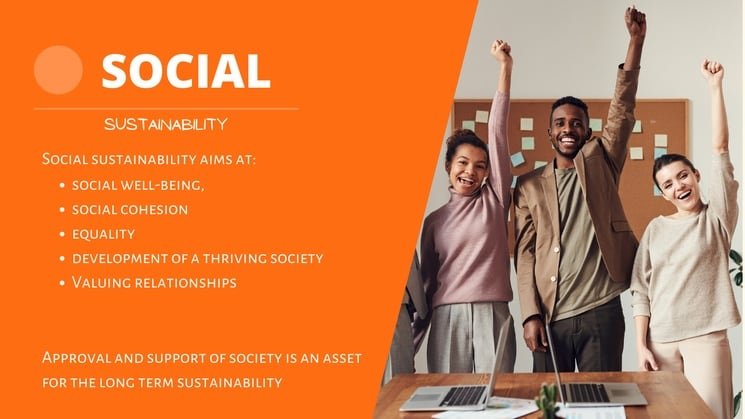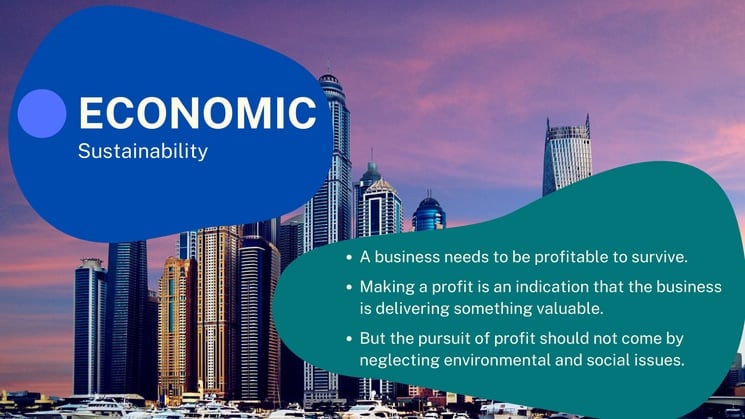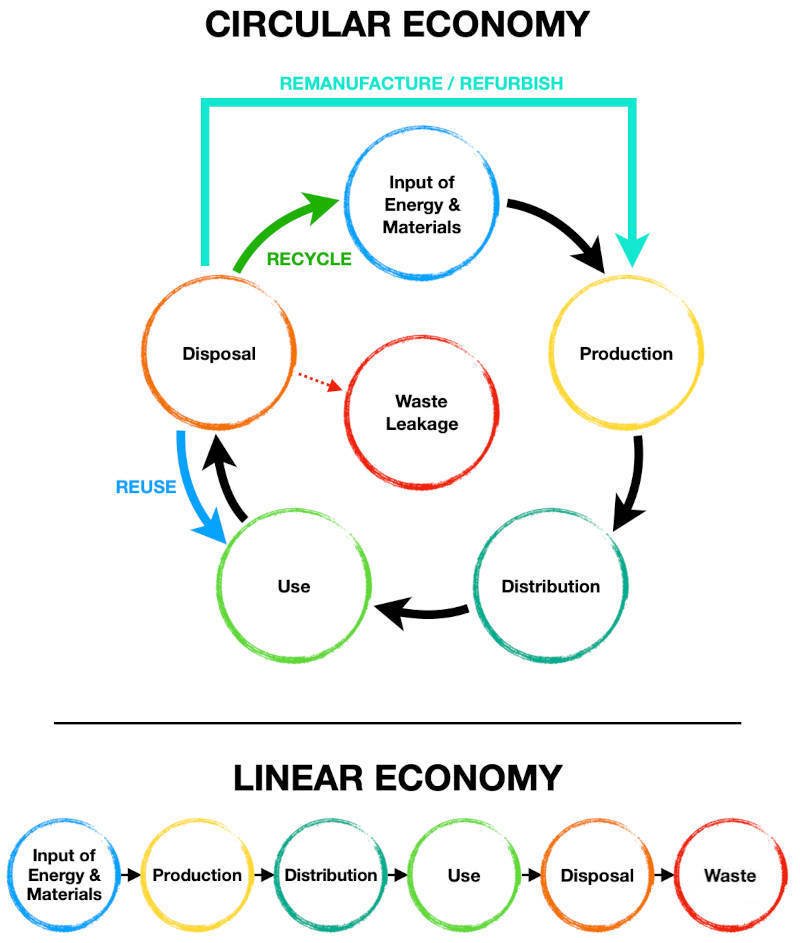The four pillars of sustainability are a variation of the much more popular framework of the three principles of sustainability. This framework is offering an alternative point of view regarding sustainable development, with more emphasis on the human factor.
The four pillars of sustainability are Human, Social, Economic, and Environmental. Those are the 4 distinct areas where sustainability needs to be achieved to have sustainable development.
Key Takeaways
- Incorporates human, social, economic, and environmental sustainability.
- Balances societal well-being, economic growth, and environmental care.
- Ensures long-term viability and well-being across all aspects.

What do the four Pillars of sustainability represent in sustainable development?
The four pillars of sustainability (4 Ps) represent a framework that businesses and individuals can use to understand how to achieve sustainable development.
This means that, as shown in many examples, if a company is focusing only on profit (the economic side), it’s not sustainable because the environment, society, and the people will sooner or later present the bill.
Sustainable development is the sweet spot where human, social, environmental, and economic needs can be satisfied all at the same time without neglecting one other. For example, a business is sustainable when is:
- Profitable and growing
- Cares about its employees by paying reasonable salaries, offering benefits and education
- Cares about the local community and society at large by supporting local charities
- Respecting the environment thanks to sustainable product design and green technologies
This is because sustainable development is at the intersection of the human, social, economic, and environmental types of sustainability. Let’s now explore more in detail the different types of sustainable development pillars.
human sustainability pillar

Human sustainability focuses on nurturing and developing the human component of an organization and society at large. Human sustainability examples include things such as access to food, water, healthcare, education, justice, fair working conditions, development of skills, and respect for human rights in general.
Human sustainability is one of the four pillars of sustainability, this means that, given limited natural resources, its achievement needs the right balance between continual economic growth and wellbeing, a thriving society, and respecting the environment.
As stated in Organizational Change for Corporate Sustainability, focusing on the human rights and needs of anyone involved in the business at any level, directly or indirectly related to the provisioning of the product or service is the way to practice human sustainability.
Human sustainability is a key element of business success because it is only by getting the backing of employees and all the people working in the company’s supply chain that sustainable long-term growth can be achieved.
The business pursuing human sustainability should have values that recognize and promote the development of human capital.
Business activities are inevitably going to impact the communities they operate in, directly or indirectly, depending on their methods and supply chain.
Human sustainability is stimulating the business to develop skills and methods to reduce the negative impact on global communities while becoming a positive force for the development of a healthy society.
Social sustainability pillar

Social sustainability aims at ensuring the well-being, cohesion, equality, and development of society by creating inclusive infrastructure thanks to sustainable urban design, as well as products, and services that can benefit the community at large.
Among the four principles, the social pillar of sustainability focuses on peace, improving social relationships, inclusivity, and equality. Preserving regional culture, and promoting honesty, and reciprocity within the local community are some of the fundamental factors contributing to achieving the social UN sustainable development goals (SDG).
The social pillar of sustainable development supports the creation and development of communities with thriving social relationships and increased economic opportunities, while at the same time respecting the environment.
For businesses, this means also contributing to the improvement of the general social development of the environment they operate in.
This may include things such as charitable donations or giving preference to suppliers operating responsibly within the local community.
Benefiting directly or indirectly from the local socio-economic community the business operates or deals with is extremely important. Being a socially responsible business will help to achieve the long-term success that companies are looking for.
economic sustainability pillar

Economic sustainability means that a business needs to be growing and profitable to be sustainable, without profit the organization would not survive.
Adding economic value is also an indirect indication that the company is delivering something useful and valuable to society. This is the foundation of the free market: if your product is not useful or there is already too much of it available on the market, you will hardly get any profit from it.
For those reasons, this pillar of sustainability is an essential component to achieving sustainable development and ensuring the success and viability of the business long term.
The economic principle is one of the 4 principles of sustainability. Economic sustainability is focusing on the efficient use of resources to improve profitability and achieve economic growth to improve the standards of living.
This however should not happen by neglecting the other areas of sustainability, but there should rather be a synergy to create prosperity without negatively impacting people, society, and the environment.
The problem with this vision is that modern accounting doesn’t consider social and ecological costs when writing down a business balance sheet. If there are no specific government regulations, the environmental issues and social costs are simply neglected, because in most cases companies have no financial liabilities for depleting resources or causing issues to society.
In recent years governments have been promoting research to close this gap and design new regulations aimed at solving or reducing the problem. The circular economic model has also been proposed as a way to overcome some of the issues of the current linear model.
The circular economy is changing the traditional way of doing business by pursuing zero-waste policies and mindful use of natural resources.

environmental sustainability pillar

Environmental sustainability aims at improving human wellbeing and long-term sustainability by preserving the environment and more rational use of natural resources.
Ecological sustainability is the last of the four pillars of sustainability and it promotes a business model that doesn’t do any harm to the environment and society, while at the same time achieving economic growth.
We can find many environmental sustainability examples in the modern world, from sustainable forest management to sustainable construction and smart buildings technology.
Corporate sustainability means that a business should responsibly consider the impact on the planet of the organization’s operations and strategy, as well as the consequences on society. This is one of the main challenges to achieving sustainable development.
Environmental sustainability in business can be pursued in many ways, for example:
- Choose a local supplier instead of an international one.
- Switch to renewable energy and reduce CO2 emissions thanks to green technology.
- Modernize your infrastructure and implement a digital transformation: this will improve the efficiency of your business, making it both more eco-friendly and more profitable.
- Promote recycling throughout the business and improve product design to make it easier to recycle base materials.
- Improve processes and design cycle by switching to more innovative technologies and using more environmentally friendly materials.
- Plant and preserve as much as possible trees and forests.
The beautiful thing is that each one of those steps will not only reduce the corporation’s impact on the planet but very often will also lead to products of better quality and increased profitability! This is a win-win scenario that you can’t afford to pass on or your business may risk becoming uncompetitive in the coming years.
Why are the four pillars of sustainability (4 Ps) so important for your business?
A sustainable business should have a proactive approach towards the planet, people, society, and profit. The four pillars of sustainability (4 Ps) offer a model you can rely on to future-proof your organization.
Climate change, loss of biodiversity, and the eventual depletion of natural resources can’t be ignored any further. Given the growing public, government, and investors’ awareness regarding environmental and social issues, sustainability is going to be a dominant theme for the current decade.
The earlier you can align your corporation with this growing trend, the better it will be for everybody, especially for your business’ competitiveness.
The old business model was focusing on the short-term profit for the shareholders, leading to neglect of environmental impact and adopting practices that could harm society, such as exploitation of workers, child labor, and others.
This short-term mentality leads us to the challenges we are facing today, such as inequality and a long list of environmental issues: from climate change to plastics in the oceans, deforestation, and more. This shorter-term thinking is clearly not sustainable and nature is starting to come back to bite us.
The new business model that will become dominant in this decade is instead focusing on sustainable development and the four pillars of sustainability. Allowing us to tackle the social and environmental problems caused by the mistakes we made in the past.
The four pillars of sustainability are so important for your business also because:
- The consumer is going to prefer more and more brands that can demonstrate environmentally conscious actions and sustainable business practices.
- Governments will very likely impose more regulations and mechanisms to factor in the environmental cost of business operations. One of those is for example the “carbon market” where more virtuous businesses can trade carbon credits with the less sustainable ones. The less environmentally friendly corporations are mandated to offset their emissions by purchasing those credits. This creates an economic incentive for businesses pursuing energy efficiency and a disadvantage for those who are not.
- Banks and investors are considering more and more ESG metrics (environmental, social, and governance) when deciding where to allocate funds. The result is that sustainable organizations will have easier access to credit and investments to grow the business.
- Recent data published by McKinsey show that adopting the right Industry 4.0 technologies and pursuing sustainability can lead to increased business resilience, efficiency, and profitability:
- Covid pandemic Industry 4.0 response: out of 400 companies, 94% of them reported that their Industry 4.0 helped to keep the business running. While 56% added that their recent digital transformation efforts were essential for their crisis response.
- Industry 4.0 adoption: “Advanced analytics-enabled scheduling and dispatching increased personnel efficiency by 50 percent, while a manufacturing control tower eliminated rework and an IoT-enabled manufacturing system reduced material cost by 10 percent.” Those results are not only improving business competitivity and profit margins but are also leading to increased sustainability as a result of the improved efficiency.
In conclusion, it is very important for the modern business leader to be aware of the current trends regarding sustainability and the coming green technological innovations and their goals, allowing the organization to stay ahead of the curve and benefit from the coming transformation.
Adopting responsible company policies according to the four pillars of sustainability, and the way profit is considered, can lead to important medium and long-term benefits in multiple areas.
The best way to pursue those objectives is to incorporate the principles of the four pillars of sustainability in the corporate strategy, allowing the organization to find the right balance between human, social, environmental, and economic factors.
Always remember that, in the long run, not taking care of the human capital and the ecologic capital of our planet can lead to severe costs and damages to your organization, so you may want to use some inspiring sustainability quotes to support the right mindset and promote green values in your business. While on the other hand there are many opportunities that can not only make the world a better place but also benefit your company.
Finally, pursuing new digital transformation technologies and the transition to industry 4.0 can not only increase profitability but also lead to improvements in all the four pillars of sustainability.
For all of those reasons, being at the forefront of technology has never been soo important and you should take action now!
What does ESG stand for?

ESG stands for Environmental, Social, and Governance. Those are KPIs (Key Performance Indicators) used by some large institutional investors when deciding if they want to invest in a specific business.
With the increased attention of the public and institutional investors on ESG and considering the importance of sustainable development for the corporate strategy, becoming a green business is rapidly climbing at the top of the list for most business leaders.
The business management and operations should not be purely based on economic considerations, but should also take into account the human, social and environmental factors and implications. Ensuring environmental responsibility should be part of the key targets of the business, together with other economic and social objectives.
Finding the right balance between those principles should be a very important part of the long-term corporate strategy, fostering a sustainable business culture both in the organization and externally. If done correctly, those policies can lead to important positive returns in terms of economic competitiveness, product quality, and brand awareness.
Conclusions
When looking at the sustainable development pillars and aspects of sustainability, those 4 principles are of fundamental importance to achieving a sustainable future and every organization should take them into account when operating.
The application of those four sustainability types will lead to improved human wellbeing, thriving communities, and respect for the environment while at the same time ensuring continued economic growth.


